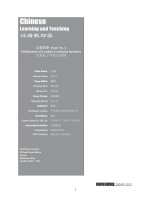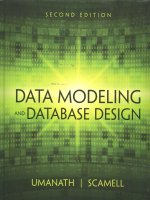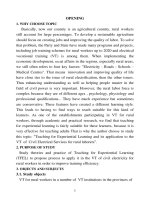Blended learning and online tutoring planning leaner support and activity design
Bạn đang xem bản rút gọn của tài liệu. Xem và tải ngay bản đầy đủ của tài liệu tại đây (1.13 MB, 222 trang )
Blended Learning and
Online Tutoring
Planning Learner Support and Activity Design
Janet Macdonald
GOWER e-BOOK
Blended Learning and Online Tutoring
This page intentionally left blank
Blended Learning and
Online Tutoring
Planning Learner Support and Activity Design
Second Edition
JANET MACDONALD
© Janet Macdonald 2008
All rights reserved. No part of this publication may be reproduced, stored in a retrieval system
or transmitted in any form or by any means, electronic, mechanical, photocopying, recording
or otherwise, without the prior permission of the publisher.
Published by
Gower Publishing Limited
Gower House
Croft Road
Aldershot
Hampshire GU11 3HR
England
Gower Publishing Company
Suite 420
101 Cherry Street
Burlington, VT 05401-4405
USA
Janet Macdonald has asserted her moral right under the Copyright, Designs and Patents Act,
1988, to be identified as the author of this work.
British Library Cataloguing in Publication Data
MacDonald, Janet, 1950–
Blended learning and online tutoring : planning learner
support and activity design. – 2nd ed.
1. Blended learning 2. Distance education
3. Telecommunication in education
I. Title
371.3'58
ISBN-13: 9780566088414
Library of Congress Control Number can be obtained from the Library of Congress.
Printed and bound in Great Britain by TJ International Ltd, Padstow, Cornwall.
CONTENTS
List of Figures
List of Tables
Acknowledgements
Preface to Second Edition
ix
xi
xiii
xv
1
Introduction
Distance technologies: potential and pitfalls
Blended learning and blended teaching strategies
What this book contains
Who this book is for
A personal reflection
1
1
2
4
5
6
PART I
APPROACHES TO BLENDED LEARNING
2
Tutor-Mediated Support: Reflecting on Present Practice
The SOLACE project
Blending support strategies
Supporting the group
Supporting the individual student
Convergence of campus-based and distance contexts
Summarising contact with groups and individuals
In summary
11
11
12
15
16
17
18
20
3
Tutors’ Perceptions of Effective Intervention
What makes for good quality?
Intervention quality and media choice
Which qualities do you value?
In summary
21
21
26
28
30
vi
BLENDED LEARNING AND ONLINE TUTORING
4
Blended Learning and Pragmatism
A survey of current practice
Common components of blended learning
The teaching and learning environment
In summary
31
31
33
34
43
5
Blended Learning and Pedagogy
The contribution of asynchronous support
The contribution of face-to-face support
Pedagogy meets pragmatism
In summary
45
45
47
51
52
PART II ONLINE TUTORING
6
7
8
9
Supporting Students Using Asynchronous Tools:
Forums, Wikis and Blogs
What tools are available?
Models of asynchronous support
Group size
Summarising the options for asynchronous support
Not working well?
In summary
57
57
58
59
75
75
77
Handy Techniques for Moderators:
Online Asynchronous Groups
General techniques
Techniques for particular tools
79
79
83
Supporting Students Using Synchronous Tools:
Chat, Audio Conferencing and the Rest
What tools are available?
Models of synchronous support
In summary
89
89
92
100
Handy Techniques for Moderators: Online Synchronous
Groups
103
General techniques
103
Techniques for particular tools
105
CONTENTS
vii
PART III DEVELOPING INDEPENDENT LEARNERS:
ACTIVITY DESIGN
10
The Experience of Blended Learning
What are the practical implications?
What makes a competent online learner?
Does online learning suit all students?
In summary
111
111
114
118
120
11
Course Design for Blended Learning
Keeping students on course and in tune
Constructive alignment and learning design
The roles of assessment
In summary
123
123
128
130
133
12
Developing E-Investigators
Advantages of electronic resources
How do students come to be e-investigators?
Deciding on relevance
Searching for information
Using resources appropriately
In summary
135
135
136
140
140
143
147
13
Developing E-Writers
Writing to understand: note-taking
Writing assignments
Practising for exam writing
Collaborative writing
In summary
149
149
153
158
159
160
14
Developing E-Communicators and Collaborators
What is involved in online communication?
Starting off
Online collaborative learning
In summary
161
161
162
164
174
15
Staff Development for Blended Learning
Practical considerations for tutors
Practical considerations for staff developers
172
177
178
viii
BLENDED LEARNING AND ONLINE TUTORING
Approaches to staff development
In summary
180
166
Appendix 1 Blended Learning Case Studies
189
Bibliography
Index
193
199
LIST OF FIGURES
Figure 4.1
Figure 6.1
Components of blended learning
Use of a wiki for alumni support on an Open University
course
Figure 8.1 Online synchronous tools for teaching languages
Figure 8.2 Librarians On Call. The library runs a help service for
enquirers using text chat
Figure 10.1 The learner’s experience of e-learning
Figure 11.1 Example learning contract
34
73
95
99
113
127
This page intentionally left blank
LIST OF TABLES
Table 2.1
Table 2.2
Table 2.3
Table 3.1
Table 3.2
Table 3.3
Table 4.1
Table 6.1
Table 6.2
Table 6.3
Table 8.1
Table 10.1
Table 11.1
Table 12.1
Table 15.1
SOLACE log showing a week’s activities with tutorial
group A
SOLACE log showing a week’s activities with tutorial
group B
Summarising contact with groups and individuals
Comparing media and communication
Your views on quality in intervention
Choosing appropriate media
Pragmatic concerns on the adoption of blended learning
The functions of asynchronous tools
Small group activities and appropriate tools
Models of asynchronous support
The functions of synchronous tools
Orientations to study
An example of a study schedule
Plagiarism. Summary of good practice recommendations
Categories of online staff forum
13
14
18
27
28
30
41
58
61
76
90
118
126
145
185
This page intentionally left blank
ACKNOWLEDGEMENTS
I would like to thank Peter Syme, Director of the Open University (OU) in
Scotland, and many other colleagues at the OU, both in Scotland and in other
parts of the UK, who contributed moral support, and who read parts of the
script or gave me helpful comments.
I’m indebted to the many OU tutors who supplied the ‘bright ideas’ which
feature throughout this book, and who also participated in the SOLACE
project. Many OU students have also contributed their perspectives on using
a computer for study.
I am particularly grateful to Sylvia Warnecke and the Languages, Maths and
Computing tutors at the Open University in Scotland, who have contributed
greatly to my understanding of differences in approaches to supporting
students in their three very different disciplines, and to good practice
guidelines in using synchronous tools, through a project on synchronous
tuition in which we were recently engaged.
I was delighted to hear from so many contributors to the blended learning
survey, and have learnt much from those who so kindly sent me case studies.
My particular thanks go to Sonja Cameron for her contribution in working
with me in the analysis of the data.
I am grateful to Anne Gaskell and co-authors of the Supporting Students by
Telephone toolkit, since many of the good practice guidelines for telephone
tuition which they have collected apply equally well to other synchronous
tools.
I am grateful to the Scottish Higher Education Funding Council (now the
Scottish Funding Council), and also to the Centre for Research in Education
xiv
BLENDED LEARNING AND ONLINE TUTORING
and Educational Technology, Open University UK, for funding two projects
described in this book.
Finally, my family, Murdo, Ewan and Kirsten, have patiently put up with my
book writing and mental absences over the past year, and they have my love
and thanks.
PREFACE TO SECOND EDITION
Since the first edition was published in 2006, there has been great interest in
Web 2.0 technologies and their potential for use in an educational environment.
While I believe the general principles set out in the first edition of my book
still hold true, there are certainly more tools to choose from now and some
of the purposes for which universities have traditionally used forums may in
future devolve to other tools. This second edition has therefore incorporated
many new examples of good practice, making use of a combination of tried
and tested tools as well as blogs and wikis for supporting students.
There has also been a recent rise in the use of activity-based learning and interest
in its potential for supporting students in distance and online environments. I
have therefore taken the opportunity to incorporate many new exemplars of
learning activity design in the third part of this book, to illustrate approaches
to the development of critical and independent learners.
In preparing for this edition and in keeping with the importance I attach to
the perspectives of practitioners, I ran a book wiki in the summer of 2007,
to canvas for new examples of good practice. My particular thanks to those
who contributed: their ideas have greatly helped in my writing.
Janet Macdonald
This page intentionally left blank
CHAPTER 1
INTRODUCTION
The word ‘blended’ is not particularly scientific, or even academic. In fact,
you might feel that it sounds rather more like an entry from a recipe book. At
the same time, it is currently widely in use by practitioners in both academic
and commercial sectors, and I believe it has some good common-sense value
in bringing to the fore the wide variety and richness of situations in which
learning takes place. It can encourage us to stop and think about the whole
context of teaching and learning, so that we remember the human element
in tutorials, or perhaps incidents such as chance meetings in the corridor, as
critical parts of the package alongside any technology-mediated intervention
with a group.
With changes in student demography, increasingly large classes, and a growth
in part-time study, many course developers and tutors are turning to online
media for teaching and learning. However, challenges and tensions arise
where institutions are also concerned with widening access and retention.
Very often tutors find that online approaches do not work quite as the books
say they should. There are questions to address. Is online learning appropriate
for all my students; does it represent a cost-effective use of the tutor’s time;
are we supporting our students, or abandoning them? In this chapter I set
out some of the issues, then outline what the book contains and who I think
might be interested in reading it.
DISTANCE TECHNOLOGIES: POTENTIAL AND PITFALLS
Distance technologies have opened up new potential in higher education, and
the literature is full of enthusiastic predictions. For example, networks offer
scope for new ways to access and combine information using the limitless
resources of the Web. Students at a distance, or separated from their peers
2
BLENDED LEARNING AND ONLINE TUTORING
for other reasons, no longer need to work in isolation but can join other
learners in an electronically supported community. These developments
offer the possibilities to develop greater self-direction in learners and to
move away from teacher-directed approaches to teaching and learning.
Instead of receiving information or knowledge from the teacher, students can
be encouraged to seek out information for themselves and to develop their
understanding by reflecting on course concepts with their peers. In these new
approaches, there is a greater importance attached to understanding, rather
than simply memorising and reproducing facts.
These are optimistic horizons, and conjure up a halcyon view of networked
study. At the same time, we know that not all students like learning exclusively
online, or perhaps the experience was not quite what they expected. They
may not participate fully and can even vote with their feet. There are
serious health warnings in terms of student retention on some courses which
wholeheartedly embrace online learning.
It is time we looked at good practice in online tutoring in the context of
what we know about our students, what else we do with them, how we
support them, and what other opportunities they have for learning from
each other. It makes sense: after all, the experience of studying online
while sitting in a computer lab, with the possibility of exchanging ideas
or the odd joke with fellow students sitting next to you will be very
different to that of students who are studying at home, with only a computer
for company.
BLENDED LEARNING AND BLENDED TEACHING STRATEGIES
Blended learning is something of a hot topic nowadays, but like the term
‘e-learning’, everyone has a different understanding of what it means.
Early references to blended learning come from industry and workplace
learning, although recently it has become more widely adopted in higher
education (HE) institutions. The term is commonly associated with the
introduction of online media into a course or programme, while at the
same time recognising that there is merit in retaining face-to-face contact
and other traditional approaches to supporting students. It is also used
where asynchronous media such as email, forums, blogs or wikis are
deployed in conjunction with synchronous technologies, commonly text
chat or audio.
INTRODUCTION
3
Blended learning seems to have arisen from a general sense of disillusionment
with the stand-alone adoption of online media. Many people felt that the
promise of online media was somehow unfulfilled. In fact, Mason (2002)
comments: ‘... the earlier e-learning adopters have come full circle in rejecting
an “either or” view of learning online versus face-to-face ... so called blended
solutions often offer the most satisfactory outcomes’. Laurillard (2002)
suggests that a balance of media is essential to make learning and teaching
effective, and the information and communications technology (ICT) element
is unlikely to contribute to more than 50 per cent of the total strategy.
In this book, I discuss the effective support of student learning by focusing first
on the academic purpose of intervention, which will be influenced in turn by
course learning objectives and student needs. The adoption of communication
tools or of activity in a classroom follows from this understanding of what
the course designer is trying to achieve. That choice will also be influenced
by the institutional environment and the alternatives available: attendance for
classroom activity is far easier to achieve for a partially campus-based course
than it might be for a course which is exclusively for distance students. In this
way I describe blended learning as the principled adoption of strategies and
media to support course objectives and enhance responsiveness to student
needs.
I intend to develop a more detailed description of the characteristics of
blended learning later in this book, but I should point out that there has
already been much useful and relevant work in the field, from people who
have not used the term blended learning, and yet refer to the same or very
similar concepts. For example, papers on online or networked learning very
often refer incidentally to the use of synchronous face-to-face or telephone
tuition sessions, alongside the use of online asynchronous learning.
Networked learning in undergraduate education in the UK is rarely – probably never
– used without some kind of opportunities for face-to-face interaction. The tendency
is to find ways of blending CMC [computer-mediated communication] with more
traditional forms of activity, seeking to get the best from a mix of different methods.
(Goodyear et al., 2005)
Another term with similar connotations is ‘distributed learning’, meaning a
convergence of traditional distance and on-campus education. In fact, one of the
most fascinating aspects of blended strategies is this convergence of interests
between traditional campus-based learning, and open and distance learning.
With the introduction of online media and with changing student markets and
4
BLENDED LEARNING AND ONLINE TUTORING
a greater emphasis on lifelong learning, the two contexts are not as far apart
as they once were. However, access issues in a campus-based environment are
likely to be very different to those faced by distance students.
For distance institutions such as the Open University (UK) where I work,
or for campus-based institutions with distance students, the motivation for
adopting blended strategies may hinge on the choice of both synchronous
and asynchronous alternatives to face-to-face tutorials as a strategy to
accommodate the varying geographical or temporal challenges faced by our
students. With the widespread use of online media in the population at large,
and the exciting educational opportunities that they offer, we are looking at
new ways of supporting students and reassessing what we do currently. On
the other hand, for campus-based staff whose students are readily available
for face-to-face intervention, the emphasis may be on supplementing class
contact time and providing enhanced opportunities for supporting a wide
diversity of student needs. I believe that as academic communities we have
much to learn from each other.
WHAT THIS BOOK CONTAINS
Part I of this book concentrates on current practice in blended learning, in
both campus-based and distance institutions. In Chapters 2 and 3, I discuss a
study of Open University tutors’ strategies for supporting students, and their
reflections on what they value in their contact with students. They describe a
variety of approaches to supporting students, for a wide range of reasons, and
their reflections underline the fact that no single intervention strategy using
one medium could possibly support all students effectively.
Chapters 4 and 5 describe a survey of current practice in blended learning
in 50 universities and colleges, primarily in Europe and Australasia. The
adoption of blended learning and the use of a variety of technologies are
influenced by various pragmatic and pedagogic concerns, illustrated here
with extracts from those who contributed to the survey.
Part II describes practical ways of using online tools for supporting students
in both asynchronous and synchronous environments. Online forums, blogs
and wikis can be used for tutor-mediated support in a variety of ways. The
purpose of the group and its membership have implications for the extent
of student participation, the roles of the moderator, and the time needed to
INTRODUCTION
5
support students. Chapters 6 and 7 cover best practice in the use of online
asynchronous tools.
The deployment of synchronous time with students is probably one of the
most difficult issues to resolve when designing a blended teaching strategy.
In campus-based environments, synchronous intervention has long been
associated with the delivery of content, although in many cases other
elements of student support have come into play. The move to adopt new
patterns of content delivery and support demands a critical appraisal of how
synchronous elements can best contribute to the support of students. This
is particularly important for distance students, where synchronous meetings
may be problematic. Although Chapters 8 and 9 concentrate on the use of
synchronous media, there are implications for new ways in which face-toface sessions might also be used.
Part III covers approaches to learning development for students who will
study online as part of a blended course. Very often such courses demand
a degree of self-direction and motivation which may be unfamiliar to those
who were previously used to traditional models of education. Chapter 10
describes student perspectives, and Chapter 11 concentrates on coherent
course design, which ensures that the various learning activities and
interventions are aligned with course learning objectives and authentic
assessment design. Finally, in Chapters 12 to 14, I discuss three interrelated
areas in the development of competent blended learners: e-investigating,
e-writing and e-collaborating, and illustrate this with a variety of practical
designs for developing competence and self-direction through activity-based
learning and assessment.
I have emphasised the central role of the tutor in a blended strategy. If tutors
are to be deployed in new roles, then they need appropriate training and
professional development. Chapter 15 describes tutors’ perspectives on
blended learning, and the practical constraints facing staff developers. It goes
on to discuss a variety of strategies that have been used to provide formal and
informal approaches to staff development.
WHO THIS BOOK IS FOR
I have written this book for practitioners who are contemplating blended
learning and online tutoring for their course, or staff developers who wish
6
BLENDED LEARNING AND ONLINE TUTORING
to encourage others. I hope it is a practical book. I have tried to steer away
from armfuls of references to learned articles, but at the same time have been
anxious to base my observations on the excellent work on student learning
which has been undertaken by many of my colleagues as well as my own
research.
I may be based in a distance-learning university, but remain firmly convinced
of the ground which we have in common with campus institutions. I hope
this book will find application and a readership in both camps.
A PERSONAL REFLECTION
I have lived with this book for the last year. It has been a formative experience
for me, and has led me to think long and hard about the relationship between
asynchronous and synchronous events, and the way in which I myself work
or study.
In the process of writing this book I began to realise how much the process
of writing is divided between a synchronous element, as I put ‘pen to paper’,
and an asynchronous element, as I revised subsequent drafts and rethought
ways of expressing concepts and explaining ideas at odd times of the day or
night.
When I was a research student and working some 300 miles from my
supervisors on campus, I remember well how much I valued our monthly
telephone conversations. For routine communication and even data collection
on asynchronous forums, there was no problem with my geographical location.
However, after a few weeks of asynchronous working, my progress slowed
to a standstill because I felt so isolated and alone. A telephone conversation
was enough to get me started again: it worked like a tonic, every time.
In my working life at the Open University, often in touch with colleagues who
are geographically remote, it has made me think about the value and centrality
of the personal element in the working environment, and the importance of
going out of my way to make opportunities to meet people face to face,
or over the telephone, since we otherwise rely so heavily on asynchronous
contact through email, with all its capacity for misunderstandings.
A blend of the two just makes life a bit more bearable.
INTRODUCTION
7
RESOURCES
Goodyear, P., Jones, C., Asensio, M., Hodgson, V. and Steeples, C. (2005)
‘Networked learning in higher education: students’ expectations and
experiences’. Higher Education, 50 (3), pp. 473–508.
Laurillard, D. (2002) Rethinking University Teaching. A conversational
framework for the effective use of learning technologies (London;
Routledge, second edition).
Mason, R. (2002) E-learning: What have we learnt? Improving student
learning using learning technology. Proceedings of the 2001 9th
International Student Learning Symposium, pp. 27–34.
This page intentionally left blank









